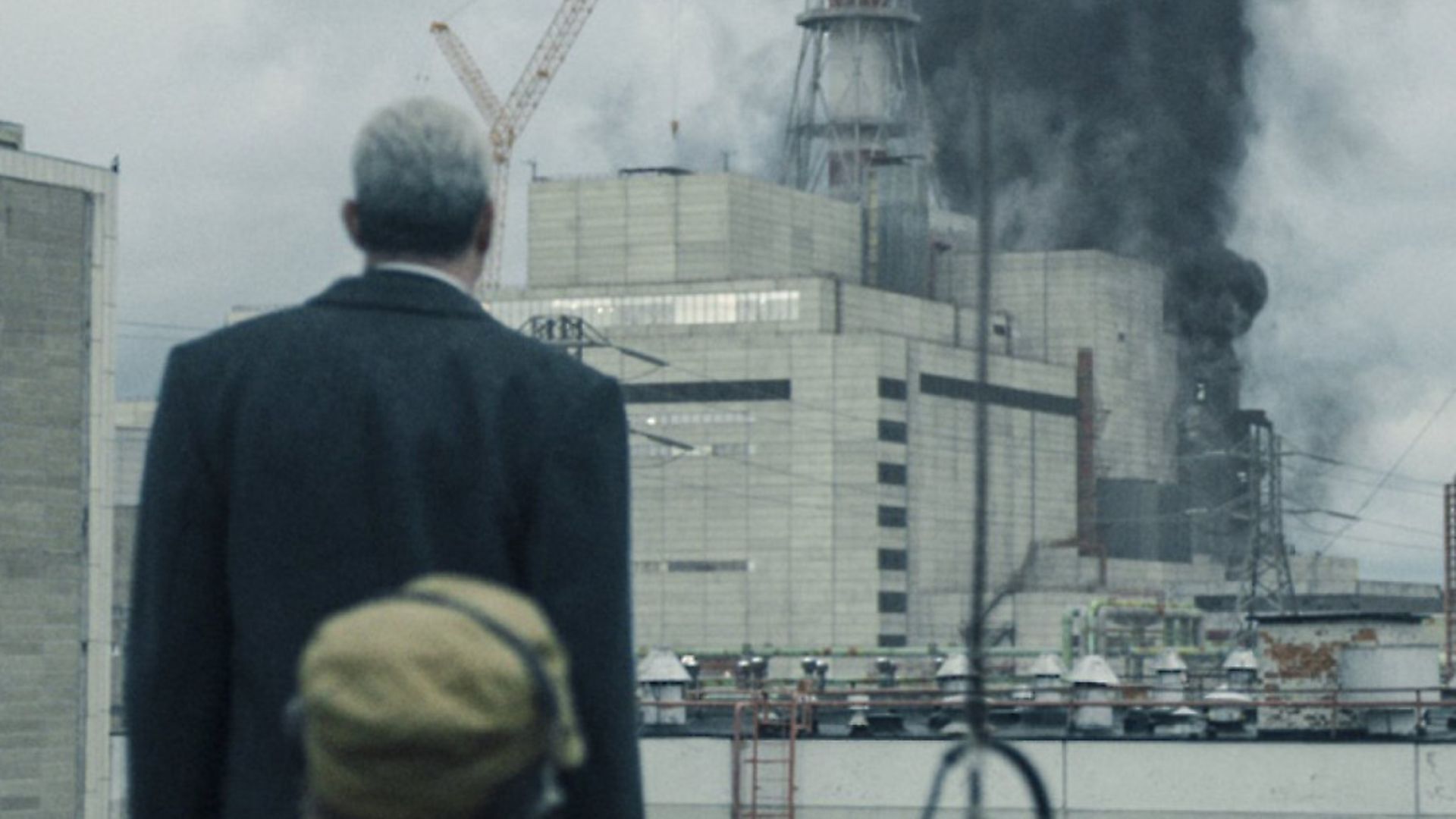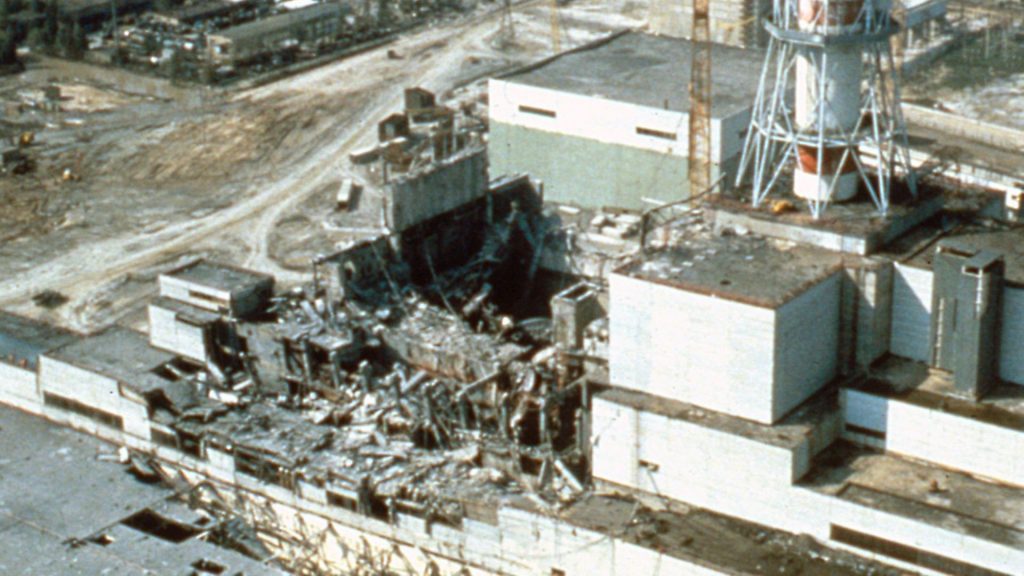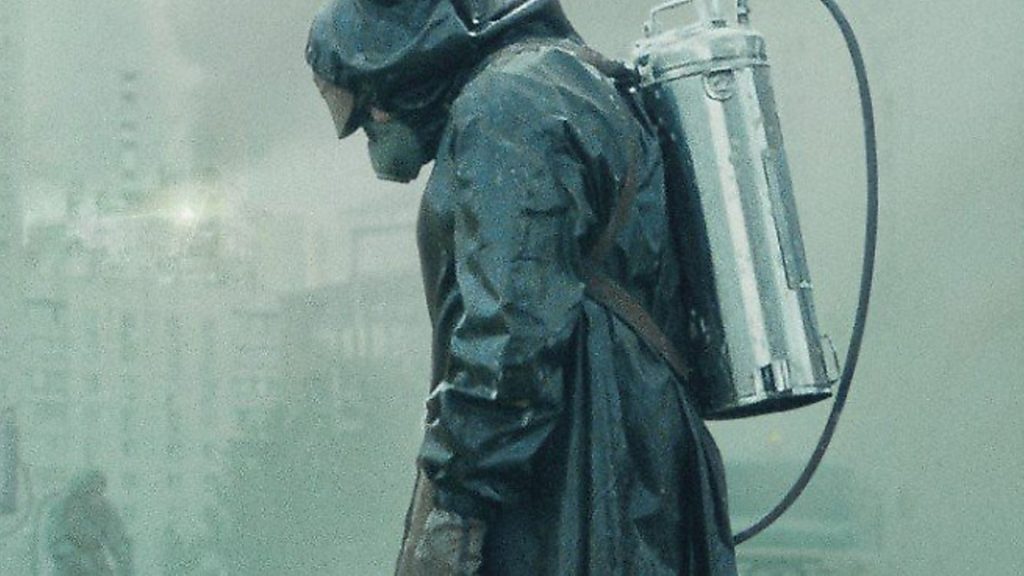
As a haunting HBO mini-series tells the story of the Chernobyl disaster, Ian Walker explains how the tragedy led to the USSR’s demise.

In Ukrainian, the word chernobyl means ‘wormwood’, the bitter-tasting plant.
But wormwood is also the name given to a devastating star, or meteorite, in the Book of Revelation:
“A great star, blazing like a torch, fell from the sky on a third of the rivers and on the springs of water – the name of the star is Wormwood. A third of the waters turned bitter, and many people died from the waters that had become bitter.”
So there you have it, if you want it, the bleak poetry in the name of the town where the world’s worst nuclear disaster took place 33 years ago; nature turned bitter, an apocalyptic catastrophe, death from the fusion found in stars.

But such poetic drama belies the everyday ordinariness of the inefficiency that caused the Chernobyl catastrophe.
The job at hand for the night staff at the V. I. Lenin Nuclear Power Station near the town of Pripyat in northern Soviet Ukraine on the evening of April 25, 1986, was the procedure of closing down the plant’s number four nuclear reactor for repairs. But before this routine job, a test was to be carried out. Engineers and scientists wanted to see whether the turbine could, as it was gradually shut down, generate enough power to keep the coolant system working.
To control the reactor, the operatives used a system of 167 graphite rods. These worked like a braking system that could either make the reactor work harder or slow it down, by controlling its fission rate.
One possible cause of all that unfolded that night was that a 26-year-old control room operator named Leonid Toptunov, made a mistake when switching from manual to automatic control of the control rods, causing them to descend much further into the core than they should.
Whatever happened, it soon became apparent that something was wrong. Power in the reactor dropped to almost zero and the operatives had to remove nearly all of the rods to keep it running.
Anatoly Dyatlov, deputy chief engineer of the plant, was overseeing the work. He was considered efficient, though in the Soviet Union efficiency usually meant no more than the ability to please your supervisors. You could be described as efficient if you were the sort of person who cut corners to try and get the job done and to hit your targets. In the Soviet Union, in the 1980s, words sometimes meant their antonym; efficiency could, in reality, mean inefficient. Sometimes, if you were inefficient enough, they would give you a medal for it.
With the reactor acting so strangely the sensible thing would have been to abandon the test, but it seems that Dyatlov was determined to finish the procedure. Most worryingly, just after the power in the reactor had dropped to almost zero, it suddenly surged. But despite this anomalous surge the test seemed to have worked. All that was left now was to shut down the reactor. And that’s when everything went wrong.
The surge – which was probably a consequence of the reactor’s instability – seems to have caused some of the control rods to fracture. This meant the operators were now unable to stabilise the reactor, as the chain reaction flared out of control. What followed were a series of explosions, one of which blew the roof off the power station. Radiation poured out as the graphite blocks and concrete building caught fire.
Twenty-eight fireman and operators would die as a direct result of the disaster, two in the blast and the rest as a result of chronic radiation poisoning. Many tales of immense heroism would later emerge – and some of these tales are dramatised in the new, HBO and Sky five-part miniseries, Chernobyl, which began this month.
Two employees, Viktor Proskuryakov and Aleksandr Kudryavtsev, died from radiation poisoning after trying to put the rods back into the reactor by hand.
Valery Perevozchikov, a colleague, helped them as he headed into the turbine room to look for fellow staff members caught in the blast.
Aleksandr Lelechenko volunteered to wade through radioactive water three times so as to cut off power to the generators. He did this so his younger co-workers did not have to be exposed to the radioactivity. After receiving first aid, Lelechenko returned to the plant to keep working.
Viktor Kibenok led the first fire crew to arrive at the scene. Initially, the firefighters thought it was a routine blaze (there had been others at the plant), but it was soon evident that the reactor was burning and that they were going to die.
They began to fall sick as they worked. One of the most chilling details to emerge was that, as they fought the fire, the radiation turned the eyes of one of the team, Volodymyr Pravik, from brown to blue.
These brave men did manage to get the fire under some sort of control, but at immense cost to their own health. They became the disaster’s first casualties. Pravik was dead within about a fortnight of the disaster, as a result of his exposure to massive amounts of radiation. Others would last longer, before ultimately succumbing to the deadly effects. It is watching the inevitability of this that makes the HBO series so compelling – and so gruesome.
In her book, Chernobyl Prayer, Nobel prize-winner Svetlana Alexievich takes a slightly different approach. She goes on to provide oral histories of the long-term effects of the disaster for those who had tackled it at close quarters, yet she opens the work not with these individual stories of heroism and sacrifice, but with figures quoted from an official Belarusian report published a decade after the incident.
Alexievich is making a point by starting her work in this way. Before getting to the devastating effects of the disaster on individual lives she tells us that 485 villages and towns in Belarus had been abandoned after the reactor exploded, seven of these were buried.
Some 2.1 million Belarusians lived in the contaminated zone and 23% of Belarus’s farmland was contaminated. Since the disaster, 264,000 acres of Belarus have been withdrawn from cultivation. A quarter of Belarus’s forest lies in the contaminated zone. And so on and so on.
Alexievich is quoting these figures because they are part of that abstract language we use to describe the horror of the last century: Six million murdered Jews; two million dead, wounded and missing at Stalingrad; one hundred thousand, or perhaps two hundred thousand – the language is often not precise – killed at Hiroshima and Nagasaki. A million dead and wounded at the Somme, 60,000 of those on the first day, and so on. These figures simultaneously measure the horror of the last century but they also make that horror abstract – they give us a scale for measuring something incomprehensible. As such, there is something deceitful in this language.
And that abstract language of numbers existed not only in measuring the horror of the last century. It was also part of the language used by various ideologies, especially the communists, to measure their successes. Communism tended to explain itself through its five-year plans, the numbers of tractors built, the tonnage of wheat grown, the amount of electricity produced, and so on.
But for the same reason that ‘efficient’ meant ‘inefficient’ in the Soviet Union, these productivity numbers were, by the 1980s, so abstract that they became meaningless. The state-run command economy was a wreck. ‘X’ amount of tractors may have been produced but they didn’t work.
The joke was that a factory hit its target of producing two hundred tons of bolts by producing two entirely useless bolts that weight one hundred tons each.
By the mid-1980s, the official growth rate in the USSR was somewhere around 4% but this official figure was a lie. The growth was closer to 1% – and even that may have been an optimistic figure.
Such a figure was unsustainable. The Soviet Union was now so far behind the USA in productivity that it was no longer a race between the two superpowers. Moreover, China was starting to show early signs of extraordinary growth in its new economic zones.
In March 1985, Mikhail Gorbachev became general security of the Soviet Communist Party. He knew that the Soviet system was in desperate need of an overhaul. Industry was inefficient and the Soviet industrial-military complex was involved in an arms race that the country could not afford.
Gorbachev was the first leader of the USSR to have not been an adult during the Second World War, which meant that he was the first whose outlook was not shaped, to the same extent, by the sentiment of ‘never again’, the Great Patriotic War and defence at all costs.
At the 27th party conference in 1986, he made it clear that change had to happen. But this wasn’t quite yet the age of Perestroika (‘restructuring’). Instead the buzzword was Uskoreniye (‘acceleration’). It was believed that technology would save the Soviet economy, and in the climate of Uskoreniye, the scientist and nuclear engineer Viktor Bryukhanov was one of the USSR’s golden boys.
Bryukhanov had overseen the building of the Chernobyl power station, which was the third-largest in the world. The plant was doing what the Soviet leadership wanted – it was overfilling its quota. In 1985, it produced 29 billion Kwh of energy. But the pressure was always on to not just maintain these levels but to exceed them. And this pressure ran right through the bureaucratic hierarchy.
Bryukhanov wanted to impress the politburo, his underlings wanted to impress him, their underlings wanted to impress them, and so on down to Anatoly Dyatlov, who was in charge of the control room of number four reactor, and who decided to ignore all safety protocols (and common sense) just so as to get the job done quickly.
But it wasn’t just the inefficacy of this command structure that was at fault. There were also inherent flaws in the design of the reactor. It was not built with safety in mind. It was built, like much in the Soviet Union (including tractor factories that could be switched to tank manufacture), as an adjunct to the industrial-military complex.
The plant’s reactors were developed from those designed to produce weapon-grade plutonium. They were essentially little more than a turbine and rotor which was added to a reactor. They worked – but they were a bit ‘cobbled together’.
From the moment they went into service, voices of concern were raised (though nowhere near enough voices) about these reactors: They were consider ‘dirty’; they leaked; they were unstable and should never have been built near urban areas.
Moreover, the work involved in constructing the buildings that housed these reactors was sub-standard. Parts didn’t fit together, the concrete was of poor quality and things were bodged. Even the test that led to the disaster felt like an improvised solution – a workaround – rather than a sensible structured and safe mechanism for working out a safe way to shut down a reactor.
So the Chernobyl disaster is the story of the failure of individual people making stupid mistakes within a system that no longer worked. It is no wonder, therefore, the makers of the new HBO drama, after they have covered the initial disaster, focus so much on the story of Valery Legasov, who is played by Jared Harris, because this is the man who probably understood this better than most.
Legasov was a senior Soviet physicist who was sent from Moscow after the meltdown to try to make sense of the conflicting reports that were being sent from Chernobyl about the nature of the disaster and about the levels of radiation that had been released.
Legasov was sceptical about the scale of the disaster and he initially behaved like many others who didn’t want to take responsibility for telling his bosses what had happened. Even after the reactor had exploded and people were dying, people seemed more concerned with trying to not upset the person above them in the bureaucratic hierarchy.
The full absurdity of this was the insistence by staff at the reactor that a Geiger counter at Chernobyl was reading 3.6 rads (probably from a broken counter) when the actual figure was closer to 100.
Fireman were collapsing and dying, as the authorities went into full denial mode. This denial went right to the top. Gorbachev himself said nothing publicly about Chernobyl until May 14, more than two weeks after the reactor had caught fire.
But Legasov knew that the entire Soviet nuclear energy programme was run in an inept way. Individuals were to blame, partly because the system encouraged a certain type of person to get on, but it was also because of the way the Soviet Union worked – or rather didn’t work. Equipment was poor, things didn’t work, too many short cuts were taken. Legaslov realised that what caused the disaster were systemic faults within the Soviet Union itself. His conclusion was that Chernobyl was the “apotheosis of all that was wrong in the management of the national economy and had been so for many decades”.
The exact death toll from Chernobyl is unknown. The estimates – from 4,000 to 200,000 – cover such a wide range as to be meaningless. Much as with the financial crisis of 2008, that 20th century language of numbers seems to have broken down. Numbers no longer seem to be able to measure reality with any precision.
But what can be described with accuracy are the historical events that followed. In the aftermath, the liquidators, the men sent into clean up and then isolate the plant, went in to do their dirty and seemingly suicidal work.
As they were doing this, and as the world saw the images from inside the smashed reactor, and of the liquidators’ hellish work, and as the people from the surrounding areas were evacuated, Gorbachev began to push Perestroika and Glasnost (‘openness’) as attempts to save the Soviet Union.
Within 24 days of the disaster, the Soviets had built the so-called sarcophagus – a large concrete bunker that would house the radioactive remains of the reactor. But within two years – not long before the Eastern European satellite states started to break away from the USSR – this typically Soviet, poorly-built structure began to fall apart. The concrete was poor quality and rain was corroding the girders.
Plans for a new containment chamber were put in place. By 1998, repairs had been made to the sarcophagus, but by now the Soviet Union longer existed and Ukraine and Belarus had become independent countries, who, at the moment of their independence, found that they inherited this apocalyptic legacy. The new safe containment shelter was finally finished last year.
The Marxist thinking that underpinned the ideology of the USSR had its roots in the capital-driven industrialisation of Britain, Germany and France in the 19th century. The Soviet Union was a failed experiment in trying to prove that socialised and state planned productivity could outstrip capitalism.
It was an experiment that tried to prove that the collective will of the people could shape nature and create a better, fairer, more advanced society.
That experiment effectively ended at Chernobyl in 1986.









